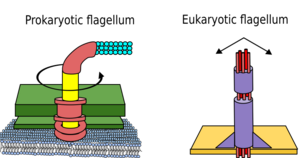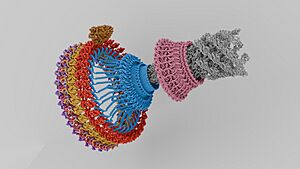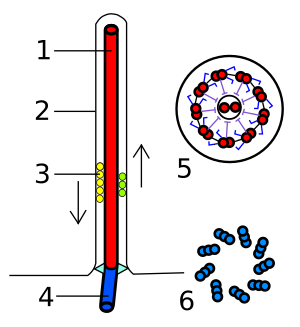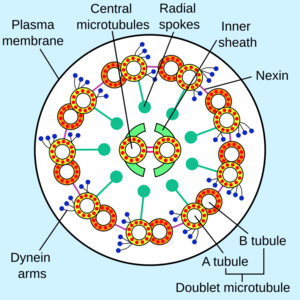Flagellum facts for kids
Quick facts for kids Flagellum |
|
|---|---|
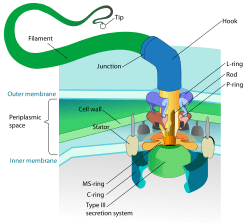 |
|
| Structure of bacterial flagellum | |
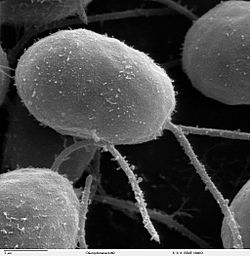 |
|
| SEM image of flagellated eukaryote Chlamydomonas sp. (10000×) |
A flagellum (plural: flagella) is like a tiny, whip-shaped tail. It sticks out from some cells and helps them move around. Think of it as a little motor that pushes or pulls the cell.
You can find flagella on many tiny living things called microorganisms. They are also on sperm cells in animals and plants, and on spores from fungi. Many protists that have flagella are known as flagellates.
Some microorganisms have just one flagellum, while others have many. For example, the bacterium Helicobacter pylori uses its flagella to swim through your stomach. It reaches the stomach lining, where it can cause problems like stomach upset. Sometimes, flagella can even sense if it's wet outside the cell.
Even though flagella help all these different life forms move, they are built differently. The flagella in Bacteria, Archaea, and Eukaryota (the three main groups of life) have unique structures. They are made of different proteins and move in different ways. But their main job is always the same: to provide movement. The word "flagellum" comes from a Latin word meaning "whip," which describes how it moves. The flagellum in archaea is sometimes called an archaellum because it's quite different from a bacterial flagellum.
Contents
What are Flagella?
Flagella are amazing tiny structures that help many cells move. There are three main types of flagella, found in the three big groups of life: Bacteria, Archaea, and Eukaryota. Even though they all help cells move, they work in different ways.
- Bacterial flagella spin like tiny propellers. They have a motor at their base that can turn clockwise or counterclockwise.
- Archaeal flagella also spin, similar to bacterial ones. However, they are built differently in many important ways.
- Eukaryotic flagella move with a bending motion, like a whip. They are found in animal, plant, and protist cells.
Eukaryotic flagella are very similar to cilia. Cilia are usually shorter and often move fluids around, while flagella are longer and help cells swim.
Now, let's look at each type more closely.
Bacterial Flagella: Tiny Propellers
How They Are Built
A bacterial flagellum is like a tiny, hollow tube made of many protein pieces called flagellin. It's shaped like a corkscrew or a helix. This long, spinning part is called the filament.
At the base of the filament, there's a bent part called the "hook." This hook connects the filament to the "basal body." The basal body is like the motor of the flagellum. It's anchored deep within the cell's membranes, with special protein rings that act like bearings. These rings help the flagellum spin smoothly.
The filament is what pushes the bacterium forward when the motor rotates it. Scientists have studied these tiny structures in great detail using powerful microscopes.
The Power Behind the Spin
The bacterial flagellum is powered by a tiny rotary engine. This engine uses a special kind of energy called proton-motive force. This force comes from the flow of tiny charged particles (protons) across the cell's membrane. It's like a tiny water wheel turned by a stream.
This motor can spin incredibly fast, up to 100,000 rpm on its own! With the flagellum attached, it usually spins between 200 and 1000 rpm. The bacterium can change the direction of spin almost instantly. This helps the cell change direction quickly.
Making and spinning a flagellum uses a lot of a bacterium's energy. It's a very efficient way for these tiny organisms to move. Bacteria can reach speeds of about 60 cell lengths per second. Imagine a cheetah running 60 times its body length every second!
How Bacteria Move
Bacteria use their flagella to move towards good things, like food, and away from bad things. They do this with a "run and tumble" motion. When flagella spin counterclockwise, they form a bundle and push the bacterium forward in a straight line (a "run").
If the bacterium needs to change direction, the flagella spin clockwise. This makes the bundle fall apart, and the bacterium "tumbles" or jiggles in place. This random reorientation helps the bacterium find a new direction to "run" in. This clever system allows bacteria to navigate their environment.
Different Arrangements
Bacteria have flagella in different numbers and patterns. These arrangements help scientists identify them:
- Monotrichous bacteria have just one flagellum at one end, like Vibrio cholerae.
- Amphitrichous bacteria have one flagellum at each of their two opposite ends, like Campylobacter jejuni.
- Lophotrichous bacteria have a tuft or cluster of flagella at one spot on their surface, like Helicobacter pylori. These flagella work together.
- Peritrichous bacteria have flagella all over their surface, pointing in every direction, like E. coli.
Some bacteria, called Spirochetes, have special flagella called endoflagella. These flagella are inside the cell, between its layers. When they spin, the whole bacterium moves in a corkscrew motion. This helps them move through thick, gooey materials.
Working Together: Bundling
When a bacterium has many flagella, they often work together. This is called bundling. The flagella gather into a single, rotating bundle. This bundle acts like a powerful propeller, pushing the cell forward.
When the cell needs to change direction, the flagella unbundle. They stop working together, causing the cell to tumble. This tumbling helps the bacterium randomly reorient itself. Then, the flagella can bundle up again and start a new "run" in a different direction. This process is very important for bacteria to find food or move away from danger.
Eukaryotic Flagella: Whips and Cilia
Structure: The 9+2 Pattern
The inside of a eukaryotic flagellum is called an axoneme. It's a very organized bundle of tiny tubes called microtubules. There are nine pairs of microtubules arranged in a circle, with two single microtubules in the center. This is known as the "9+2" pattern.
At the very base of the flagellum, inside the cell, is a structure called the basal body. This basal body helps organize the microtubules and anchors the flagellum to the cell. The entire flagellum is covered by the cell's outer membrane.
How They Move
Eukaryotic flagella move with a bending, wave-like motion, much like a whip. This movement is powered by a molecule called ATP (adenosine triphosphate), which is the cell's energy currency. Special proteins called dynein arms, located between the microtubule pairs, use ATP to slide the microtubules past each other. This sliding causes the flagellum to bend.
Flagella versus Cilia
Eukaryotic flagella and cilia are very similar in their basic "9+2" structure. However, they often have different lengths and ways of moving. Flagella usually create a long, wave-like motion to propel a cell, like a sperm cell swimming.
Cilia are generally shorter and often move with a more complex "power and recovery" stroke. They can help single cells move, or they can move fluids over the surface of stationary cells. For example, cilia in your respiratory tract help sweep away dust and germs.
Where We Find Them
Eukaryotic flagella and cilia are very common in many different forms of life. They are found in almost all groups of eukaryotes. You can see them in specialized cells of multicellular organisms, like the cells that line your airways. They are also found in many single-celled organisms.
Many organisms have flagellated stages in their life cycle. For instance, some green algae and fungi produce swimming spores or gametes that use flagella. Even some gymnosperms, like cycads, have flagellated male gametes.
Archaeal Flagella: Unique Spinners
The archaellum is the flagellum found in some Archaea. At first glance, it looks similar to a bacterial flagellum because it also helps the cell move by spinning. However, scientists discovered many important differences between them.
Archaeal flagella are powered by ATP, which is different from the proton-motive force used by most bacterial flagella. Also, bacterial flagella grow by adding new parts to their tip. Archaeal flagella, however, grow by adding new parts to their base, inside the cell.
These differences show that archaeal and bacterial flagella likely developed separately over time. They are a great example of convergent evolution. This means two different groups of organisms developed similar tools (like flagella) to do the same job (movement), but they built them in different ways.
Fungal Flagella: Rare Movers
Most fungi do not have flagella. However, a special group of fungi called chytrids are an exception. They have a single flagellum on their spores. This flagellum helps these fungal spores swim through water to find new places to grow.
Images for kids
See also
 In Spanish: Flagelo (biología) para niños
In Spanish: Flagelo (biología) para niños
- Ciliopathy
- RpoF


